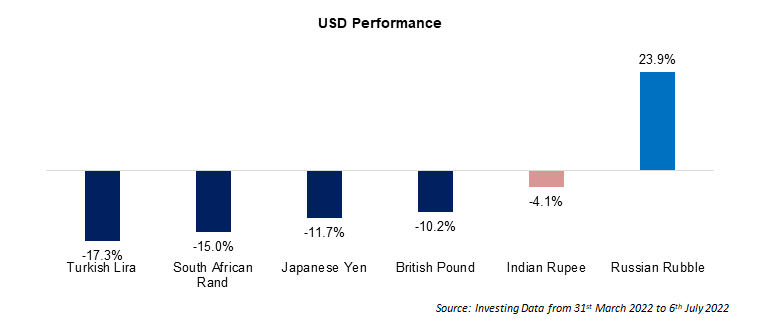
Possibilities of a global recession, high inflation rates, and a strengthening US dollar have forced global central banks to use their forex kitty to keep their currencies from depreciating too much. When it comes to India, the Indian rupee fell to a record low of Rs. 79.37 against the US dollar on 6th July 2022. So far in the fiscal year 2022-2023, the rupee has fallen by 4.1%, less than the depreciation seen across some other emerging and developed market currencies. From the start of this calendar, the year rupee has dropped by 6.26%. The chart below indicates how INR has remained resilient against other emerging and developed economies.

Besides actively using forex reserves to curb volatility in the Indian rupee, RBI has doubled its efforts by introducing macro-level measures to defend the weakening currency. Below is a summary of key measures announced by RBI:
Measures announced by RBI:
- Incremental deposits exempted from CRR/SLR:
RBI has exempted banks from maintaining statutory liquidity and cash reserve ratios on incremental foreign currency and term deposits denominated in rupee non-resident Indians between 1st July and 4th November 2022. Intended impact: Incentivise banks to raise foreign currency deposits.
- Banks are allowed to raise foreign deposits without reference to regulations on interest rates:
In addition to the above ceiling, deposit interest rates have been removed. Banks are now permitted to raise fresh deposits without reference to regulations on interest rates. Currently, deposits with a maturity of 1-3 years are taken at 250 bps over and above the alternate reference rate, whereas in the case of 3–5-year maturity, it is above 350 bps.
Intended impact: Reduce costs for banks to raise funds and ensure better returns to NRIs and attract dollar inflows.
- FPI investment norms regarding govt. bonds relaxed
There are three routes through which FPIs can invest 1) Fully Accessible Route. 2) Medium Term Framework route and 3) Voluntary Retention Route. In the case of FPI investments through a Fully Accessible Route in government securities and corporate bonds, it has been decided that all new issuances of G-secs of 7 years and 14-year tenors will be allowed. Currently, only 5-year, 10-year, and 30-year G-secs are classified under FAR.
Intended impact: Encourage increased FPI flows in government debt
Secondly, regarding investment through the Medium-Term Framework route, RBI has relaxed norms on residual maturity for FPI investments in corporate and government debt. FPI investments in these bonds are exempt from short-term limits till 31st October 2022. Currently, FPIs cannot hold more than 30% of assets with instruments having residual maturity of less than one year.
Along with this, RBI has also provided a window till 31st October for foreign portfolio investors to buy commercial papers and NCDs with an original maturity of up to one year.
Intended impact: Allow investors with a shorter investment horizon to invest. This may also help reduce short-term yields, which have inched up recently.
- ECB: Limit under the automatic route increase from $750 million to $1.5 bn
External Commercial Borrowings (ECB) limit has been increased under the automatic route from the current $750 mn to $1.5 bn.
Intended impact: Corporates borrowing overseas have more leeway to raise/roll over foreign debt.
Conclusion:
A worsening global outlook and weakness in domestic macro fundamentals will continue to weigh on the INR going forward. However, these measures by RBI may diversify and expand the foreign funding sources, which will eventually help limit the depreciation of the rupee.



























